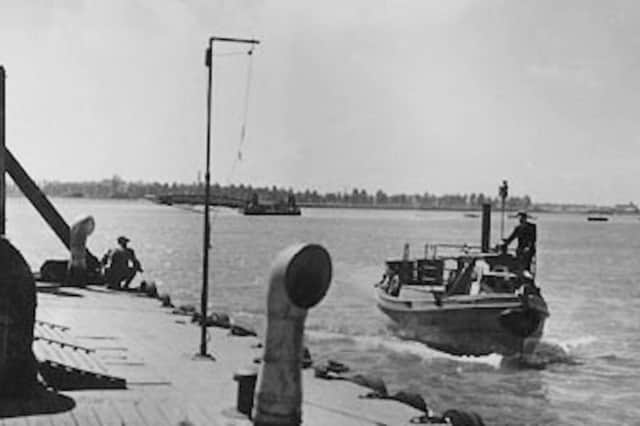Happy memories as a Hayling Ferry deckhand | Nostalgia


I wonder how many of you ever thought of dockyard employees living on Hayling Island? I know I had not.
Cycling from somewhere on the island to the ferry, crossing Langstone Harbour, then the four-mile bike ride to The Hard and into the dockyard is quite a trek.
All in all it would have been a good five-mile bike ride.
Advertisement
Hide AdAdvertisement
Hide AdTony Thatcher worked on the Hayling Ferry from October 1953 to March 1954, prior to joining the Royal Navy aged 17.
The ferry that he remembers was called Sinah.
The company was owned by the Spraggs family.
Tony says: ‘There was a father and two sons, Cecil and, I think, George, but it was mainly Cecil in charge of us.
'I remember working on two shifts.
‘The early one entailed me cycling from Orchard Road, through Devonshire Avenue, Bransbury Road and Ferry Road to get the ferry ready to pick up the dockies on the Hayling side about 6.30 for them to be at work by 7am.
‘This was all through the winter. I had to break the ice on the ropes to untie them from the mooring!
Advertisement
Hide AdAdvertisement
Hide Ad‘The man who actually ran the boat was called John, I think.
‘I was a deckhand and used to tie up the bikes and tie and untie the mooring ropes.
‘Happy days indeed. It was one of the most enjoyable jobs I ever had.’
Mike Tuttiett tells me: ‘The picture of the Hayling Ferry would have been taken in the 1970s.
Advertisement
Hide AdAdvertisement
Hide Ad‘My dad, David, was foreman of the works at Rotork Sea Truck Company in Hamworthy, Poole, Dorset, who built those landing craft type boats.
'James Dyson designed the Rotork Sea Truck.
‘He managed the project while studying at the Royal College of Art after Jeremy Fry, the chairman of Rotork, offered him a job in 1970.
‘Dyson was only 23 when he designed the boat, which carried a three-tonne load at 50mph.
‘It was used for oil and construction industries, as well as for military use.’
Advertisement
Hide AdAdvertisement
Hide Ad:: Deryck Swetnam remembers Locksway Road and the Thatched House pub which was pictured last week.
Derek says: ‘In the early fifties I seem to remember that between what was then the end of Locksway Road and the Thatched House was a scrapyard which contained what looked like the remains of a single seat fighter aircraft.
‘I wonder if any of your readers can confirm this and know what type of aircraft it was?’
:: The photograph of Unicorn Road and Unicorn Gate was seen by Ray Hallett who says: ‘I worked for the Ministry of Public Buildings and Works (MPBW) which changed to the Department of the Environment.
‘I was in the dockyard from 1962-1972.
Advertisement
Hide AdAdvertisement
Hide Ad‘After working my way through the building work section I transferred to the mobile plant section in Guard House Road at the top end of the yard.
'I drove my pieces of plant and one was a Simon Hoist.
‘For nearly nine months myself and the stonemason, a Mr Harry Briggs, worked on repairs to the gate, always on a Saturday.
‘The police would close the gates and they would be kept shut until late afternoon when we had completed the project for the day.
‘We used to clean and carry out repairs to the stonework when needed.
Advertisement
Hide AdAdvertisement
Hide Ad‘To work with an experienced stonemason like Harry was great as I learned another skill.
‘One of the older policemen on the gate, ‘Jumper' Collins was always happy as no traffic was allowed through the gate.
‘Only the small side pedestrian gate was open just for the walkers and cyclist.’
:: I see that after three months off football referees had done little to improve their fitness.
Advertisement
Hide AdAdvertisement
Hide AdLast week’s match between Brighton and Arsenal saw Brighton score a goal with the ball going in the net just inside the post to be hooked out by an Arsenal player’s hand.
The referee was undecided as to whether the ball had crossed the line.
Why? Because he was standing on the edge of the 18-yard box.
The ball came in from the left and the referee stopped running on the corner of the penalty area.
Advertisement
Hide AdAdvertisement
Hide AdIf he had kept running, keeping up with play, he would have seen the ball cross the line.
Imagine if there had not been Hawk-Eye or VAR?
What if the Hand-of-God goal – as Maradona called his handball goal in the 1986 World Cup – had been allowed? Complete uproar.
Please referees, keep up with play.